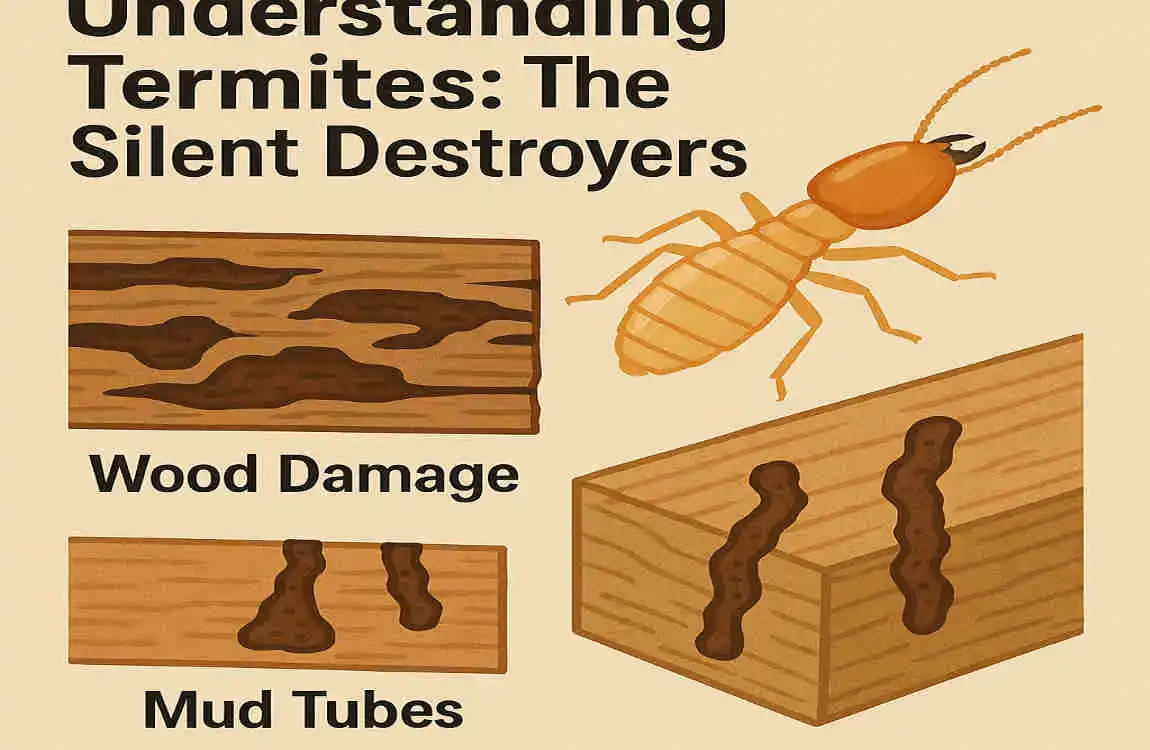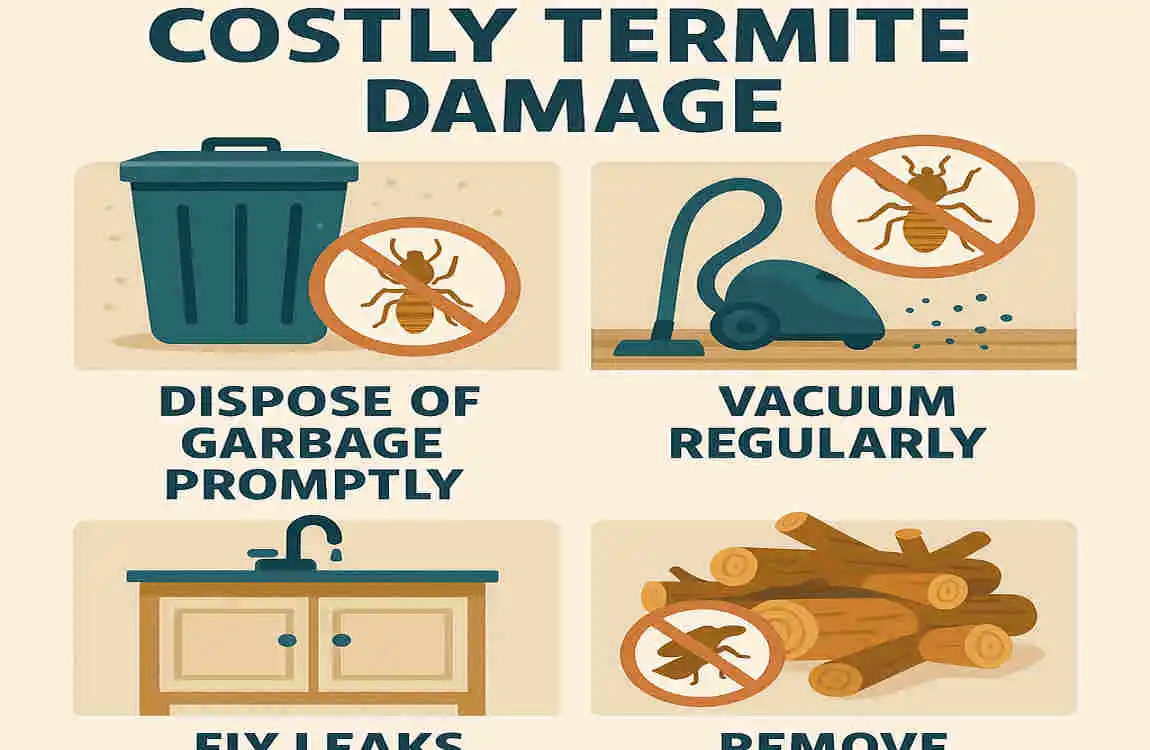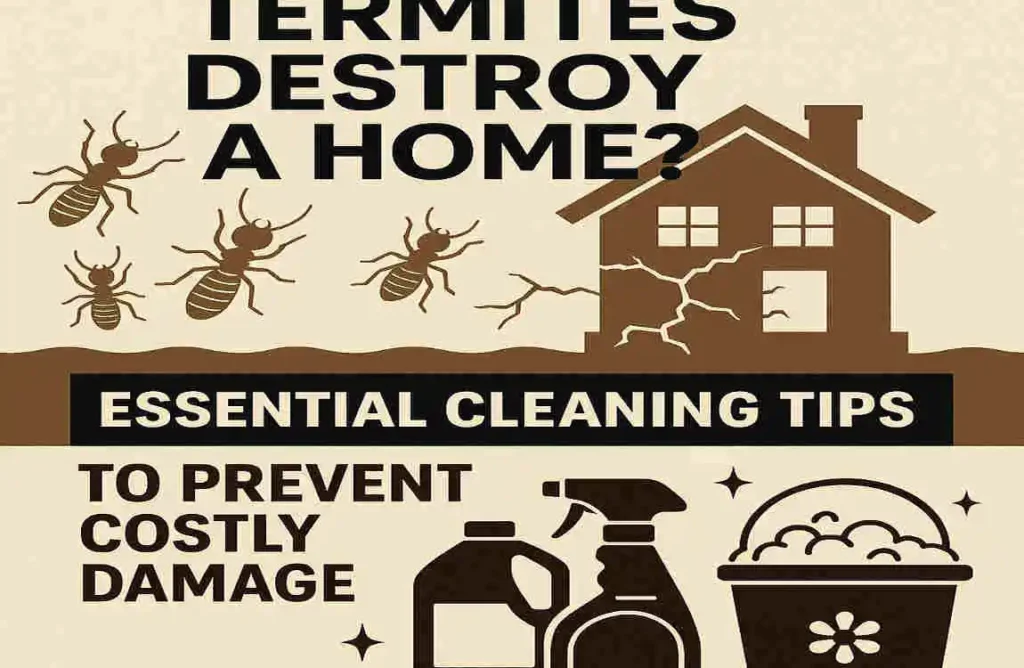Imagine waking up one morning to find your home crumbling around you. It sounds like a nightmare, but for many homeowners, it’s a harsh reality caused by termites. These tiny pests can wreak havoc on your property at a shocking speed, leaving you with costly repairs and a headache that won’t quit.
Understanding how fast termites can destroy a home is crucial for every homeowner. Understanding the timelines of termite damage lets you take proactive steps to protect your investment and prevent these silent destroyers from taking over.
Understanding Termites: The Silent Destroyers

What Are Termites and Their Role in Nature?
Termites are small insects that play a vital role in our ecosystem. They break down dead wood and other plant material, helping to recycle nutrients back into the soil. However, when these critters invade your home, they can become a significant problem.
Types of Termites Commonly Found in Homes
Three main types of termites often infest homes:
- Subterranean termites: These termites live in the soil and build mud tubes to access wood in your home.
- Drywood termites: These termites can live in dry wood without direct contact with the soil.
- Dampwood termites: These termites prefer moist wood and are often found in areas with high humidity.
How Termites Locate and Invade Homes
Termites are attracted to wood and other cellulose-based materials. They can enter your home through tiny cracks and crevices, often unnoticed until significant damage occurs.
Why Termite Damage Often Goes Unnoticed Initially
One reason termites are so destructive is that they work silently and out of sight. They can chew through wood from the inside out, leaving the surface intact while causing structural damage beneath. This makes it challenging to detect an infestation until it’s too late.
How Fast Can Termites Destroy a Home?
Average Speed of Termite Damage Progression
The speed at which termites can destroy a home varies depending on several factors. On average, a termite colony can cause significant damage within 3 to 8 years if left untreated.
Factors Affecting the Rate of Destruction
Several factors can influence how quickly termites can wreak havoc on your home:
Species of Termite
Different termite species have varying levels of destructiveness. For example, subterranean termites are known to cause more damage than drywood termites.
Size and Age of the Colony
The larger and more mature a termite colony is, the faster it can cause destruction. A mature colony can have millions of termites working around the clock to devour your home.
Type and Condition of Wood/Materials in the House
Termites prefer softwoods over hardwoods, and they can more easily infest wood that is already damaged or rotting. The type of construction materials used in your home can impact how quickly termites can cause damage.
Environmental Conditions (Humidity, Temperature)
Termites thrive in warm, humid environments. If your home has moisture issues or is located in a humid climate, termites may be able to cause damage more quickly.
Real-Life Examples or Case Studies Showing Damage Timelines
Let’s take a look at a few real-life examples of how fast termites can destroy a home:
- In one case, a homeowner in Florida discovered a termite infestation after just 2 years. The termites had already caused significant damage to the home’s wooden beams and flooring.
- Another homeowner in California found termites in their home after 5 years. The pests had eaten through the house’s wooden framing, compromising its structural integrity.
These examples demonstrate how quickly termites can cause destruction if left unchecked.
Signs of Early Termite Infestation to Watch For
Catching a termite infestation early is key to minimizing damage. Keep an eye out for these signs:
- Mud tubes: Subterranean termites build mud tubes to travel from their nest to a food source.
- Discarded wings: After swarming, termites shed their wings, which can be found near windows and doors.
- Hollow-sounding wood: If you tap on a piece of wood and it sounds hollow, it may be infested with termites.
- Frass: Drywood termites push out their fecal pellets, which can be found near infested timber.
If you notice any of these signs, it’s crucial to take action quickly to prevent further damage.
The Role of Cleaning in Termite Prevention
Why Cleanliness is Crucial in Preventing Termite Attraction
Keeping your home clean and clutter-free is one of the most effective ways to prevent termite infestations. Termites are attracted to wood and other cellulose-based materials, so by removing these from your home, you can make it less appealing to these pests.
How Clutter and debris Create Termite-Friendly Environments
Clutter and debris provide termites with easy access to food sources and hiding places. By keeping your home tidy and free of unnecessary items, you can reduce the risk of a termite infestation.
Common Areas Where Cleaning Can Reduce Termite Risk
Certain areas of your home are more prone to termite infestations than others. Focus your cleaning efforts on these key areas:
- Basements: Basements often have high humidity levels, which can attract termites. Keep this area clean and well-ventilated.
- Crawl spaces: Like basements, crawl spaces can be damp and dark, making them ideal for termites. Remove any wood debris and ensure proper ventilation.
- Gardens: Keep your garden tidy and free of fallen branches and tree stumps, which can attract termites.
Relation of Cleaning to Termite Control and Prevention
Regular cleaning is a crucial part of any termite control and prevention strategy. By keeping your home clean and clutter-free, you can make it less appealing to termites and reduce the risk of an infestation.
Essential Cleaning Tips to Prevent Costly Termite Damage

Regular Home Inspection and Cleaning Checklist
To keep termites at bay, it’s essential to conduct regular home inspections and keep the home clean. Here’s a checklist to help you stay on top of things:
- Inspect your home: Look for signs of termite activity, such as mud tubes, discarded wings, and hollow-sounding wood.
- Clean your gutters: Clogged gutters can lead to moisture buildup, which can attract termites.
- Remove wood debris: Keep your yard free of fallen branches, tree stumps, and other wood debris that can attract termites.
- Check for leaks: Fix any leaks or water damage promptly, as termites are attracted to moist environments.
Tips for Cleaning and Maintaining Key Problem Areas
Here are some specific tips for cleaning and maintaining the key problem areas we discussed earlier:
Removing Wood debris and Mulch Near the Foundation
Keep the area around your home’s foundation free of wood debris and mulch. These can provide termites with easy access to your home and a food source.
Clearing Gutters and Drains to Avoid Moisture Buildup
Clogged gutters and drains can lead to moisture buildup, which can attract termites. Clean these regularly to keep your home dry and termite-free.
Keeping Firewood and Lumber Away from the House
Store firewood and lumber at least 20 feet away from your home and off the ground. This will make it harder for termites to access these potential food sources.
Proper Disposal of Tree Stumps and Fallen Branches
If you have tree stumps or fallen branches on your property, dispose of them properly. These can attract termites and serve as a food source.
Maintaining Ventilation in Crawl Spaces and Attics
Proper ventilation is crucial for keeping your home dry and preventing termite infestations. Ensure that your crawl spaces and attics are well-ventilated and free of moisture.
Using Non-Toxic Cleaning Agents and Treatments That Deter Termites
When cleaning your home, opt for non-toxic cleaning agents and treatments that can help deter termites. Look for products that contain natural ingredients, such as orange oil, which can repel termites without harming your family or pets.
When to Schedule Professional Cleaning and Termite Inspections
While regular cleaning and inspections can help prevent termite infestations, it’s also important to schedule professional cleanings and termite inspections. These experts can identify potential problem areas and provide targeted treatments to keep your home termite-free.
Additional Preventive Measures Beyond Cleaning
Physical Barriers and Home Repairs (Sealing Cracks, Fixing Leaks)
In addition to cleaning, you can take several other preventive measures to keep termites at bay. These include:
- Sealing cracks: Seal any cracks or gaps in your home’s foundation, walls, and windows to prevent termites from entering.
- Fixing leaks: Repair any leaks or water damage promptly, as termites are attracted to moist environments.
Landscaping Best Practices to Deter Termites
Proper landscaping can also help prevent termite infestations. Keep these tips in mind:
- Avoid planting trees and shrubs too close to your home: These can provide termites with a bridge to your house.
- Use termite-resistant plants: Some plants, like marigolds and catnip, can help repel termites.
- Keep your lawn well-maintained: A well-maintained lawn can help reduce moisture levels and make your home less appealing to termites.
Use of Termite-Resistant Building Materials
When building or renovating your home, consider using termite-resistant building materials. These can include:
- Pressure-treated wood: This wood is treated with chemicals that can help prevent termite infestations.
- Composite materials: Composite decking and siding can be more termite-resistant than traditional wood.
Importance of Termite Treatment (Chemical and Bait Systems)
In some cases, preventative measures may not be enough to keep termites at bay. If you have a severe infestation, you may need to consider termite treatment options, such as:
- Chemical treatments: These can be applied to the soil around your home to create a barrier against termites.
- Bait systems: These can be used to attract termites and then eliminate them with a slow-acting poison.
Integrating Cleaning with Other Pest Management Strategies
Cleaning is just one part of a comprehensive pest management strategy. By combining regular cleaning with other preventive measures and treatments, you can create a strong defense against termites and keep your home termite-free.
What to Do If You Suspect Termite Damage
Immediate Steps to Take Upon Detecting Termites or Damage
If you suspect a termite infestation, it’s essential to act quickly. Here are some immediate steps you can take:
- Document the damage: Take photos and videos of any termite damage you find, as this can be helpful for insurance claims and treatment planning.
- Isolate the area: If possible, isolate the infested area to prevent the termites from spreading to other parts of your home.
- Contact a professional: Reach out to a pest control professional as soon as possible to assess the situation and provide treatment options.
How to Document and Assess Termite Destruction
When documenting termite damage, be sure to:
- Take clear photos and videos: Capture the extent of the damage from multiple angles.
- Measure the damage: Use a tape measure to document the area affected.
- Please keep a record: document when you first noticed the damage and any steps you’ve taken to address it.
When to Contact Pest Control Professionals
If you suspect a termite infestation, it’s always best to contact a pest control professional. They can assess the situation, identify the type of termite, and provide targeted treatment options.
Potential Costs of Termite Damage and Treatment Versus Prevention Costs
The cost of termite damage and treatment can be significant. According to HomeAdvisor, the average price of termite treatment ranges from $225 to $1,000, while repairing termite damage can be much higher, often reaching into the tens of thousands of dollars.
In contrast, the cost of prevention is relatively low. By investing in regular cleaning, inspections, and preventative measures, you can save yourself a lot of money and hassle in the long run.
